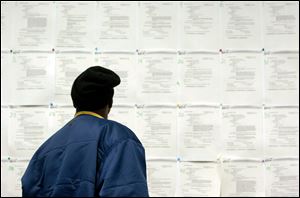
Michigan jobless rates increase as seasonal workers try to find jobs
13 regions see uptick in May
6/23/2011
Jobless rates increased in 13 of Michigan's 17 major regional labor markets in May.
LANSING, Mich. — The state says seasonally unadjusted unemployment rates increased in most regions of Michigan in May as seasonal workers looked for jobs.
The figures released Thursday by the Department of Technology, Management and Budget show jobless rates increased in 13 of the state’s 17 major regional labor markets compared to April. Total employment levels increased moderately in most regions, as did labor force levels.
Statewide, the unadjusted jobless rate in May was 10.3 percent, up from 10 percent in April.
Rates ranged from a low of 6.8 percent in the Ann Arbor region to a high of 11.7 percent in the northeastern Lower Peninsula. The Ann Arbor and Battle Creek regions saw the largest increases.
Statewide, job gains were reported in leisure and hospitality services, construction and professional and business services.
Michigan’s major labor market areas, their seasonally unadjusted jobless rates for May and changes since April:
- Ann Arbor, 6.8 percent, compared with 6.2 percent.
- Battle Creek, 9.2 percent, compared with 8.6 percent.
- Bay City, 9.6 percent, compared with 9.7 percent.
- Detroit-Warren-Livonia, 11.6 percent, compared with 11.1 percent.
- Flint, 10.9 percent, compared with 10.8 percent.
- Grand Rapids-Wyoming, 8.3 percent, compared with 8 percent.
- Holland-Grand Haven, 8.4 percent, compared with 8.1 percent.
- Jackson, 10.1 percent, compared with 9.7 percent.
- Kalamazoo-Portage, 8.7 percent, compared with 8.3 percent.
- Lansing-East Lansing, 7.9 percent, compared with 7.6 percent.
- Monroe, 9.6 percent, compared with 9.5 percent.
- Muskegon-Norton Shores, 10.4 percent, compared with 10.1 percent.
- Niles-Benton Harbor, 10 percent, compared with 9.6 percent.
- Saginaw-Saginaw Township North, 9.6 percent, compared with 9.4 percent.
- Upper Peninsula, 9.9 percent, compared with 10.6 percent.
- Northeast Lower Michigan, 11.7 percent, compared with 13.2 percent.
- Northwest Lower Michigan, 10.8 percent, compared with 11.9 percent.
- MICHIGAN, 10.3 percent, compared with 10 percent.
Source: Michigan Department of Technology, Management and Budget